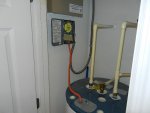streetneons
Member
- Location
- Florida
I did a home inspection on a house built in 2006 in Florida with a water heater timer, every install that I have seen in this area for a water heater timer has the wiring in conduit from the timer box to the water heater. Should the wiring be in conduit?
And while I am asking a question and learning, is there any distance requirement for an electrical switch or outlet near a kitchen sink, I had a disposal switch plate mounted on the backsplash right behind the sink and usually I seem them a bit off to the side?
And I think I found my answer but will ask the experts anyways, outlets and switches in a bathroom near a tub or shower, what is the actual requirement for the placement, I know it can't be in the shower/tub basin area, but should it be like 3 feet away from the basin, or is right on the drywall next to the shower within reach when in the shower okay?
Sorry if this seems like basic stuff, I am still learning and just looking for more information on the matter. Thank you in advance for any input

And while I am asking a question and learning, is there any distance requirement for an electrical switch or outlet near a kitchen sink, I had a disposal switch plate mounted on the backsplash right behind the sink and usually I seem them a bit off to the side?
And I think I found my answer but will ask the experts anyways, outlets and switches in a bathroom near a tub or shower, what is the actual requirement for the placement, I know it can't be in the shower/tub basin area, but should it be like 3 feet away from the basin, or is right on the drywall next to the shower within reach when in the shower okay?
Sorry if this seems like basic stuff, I am still learning and just looking for more information on the matter. Thank you in advance for any input


